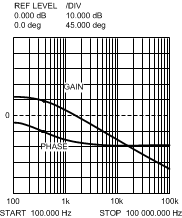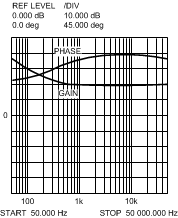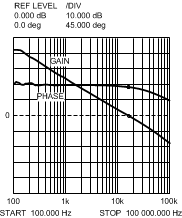ZHCSHU8F October 2008 – July 2019 LM5575-Q1
PRODUCTION DATA.
- 1 特性
- 2 应用
- 3 说明
- 4 修订历史记录
- 5 Pin Configuration and Functions
- 6 Specifications
- 7 Detailed Description
- 8 Application and Implementation
- 9 Power Supply Recommendations
- 10Layout
- 11器件和文档支持
- 12机械、封装和可订购信息
8.2.2.15 R4, C5, C6
These components configure the error amplifier gain characteristics to accomplish a stable overall loop gain. One advantage of current mode control is the ability to close the loop with only two feedback components, R4 and C5. The overall loop gain is the product of the modulator gain and the error amplifier gain. The DC modulator gain of the LM5575-Q1 is calculated by Equation 15:
The dominant low frequency pole of the modulator is determined by the load resistance (RLOAD,) and output capacitance (COUT). The corner frequency of this pole is calculated by Equation 16:
For RLOAD = 5 Ω and COUT = 130 µF then fp(MOD) = 245 Hz
DC Gain(MOD) = 1 × 5 = 14 dB
For the design example of Functional Block Diagram, the measured modulator gain vs. frequency characteristic is shown in Figure 18.

| RLOAD = 5 Ω | COUT = 130 µF |
Components R4 and C5 configure the error amplifier as a type II configuration which has a pole at DC and a zero at fZ = 1 / (2πR4C5). The error amplifier zero cancels the modulator pole and leaves a single pole response at the crossover frequency of the loop gain. A single pole response at the crossover frequency yields a very stable loop with 90 degrees of phase margin.
For the design example, a target loop bandwidth (crossover frequency) of 15 kHz was selected. Select the compensation network zero (fZ) at least an order of magnitude less than the target crossover frequency. This constrains the product of R4 and C5 for a desired compensation network zero 1 / (2π R4 C5) to be less than 2 kHz. If the user increases R4 while they proportionally decrease C5, the error amp gain increases. Conversely, if the user decreases R4 while proportionally they increase C5, the error amp gain decreases. For the design example, C5 was selected for 0.01 µF and R4 was selected for 49.9 kΩ. These values configure the compensation network zero at 320 Hz. The error amp gain at frequencies greater than fZ is: R4 / R5, which is approximately 10 (20 dB).
 Figure 19. Error Amplifier Gain and Phase
Figure 19. Error Amplifier Gain and Phase The overall loop can be predicted as the sum (in dB) of the modulator gain and the error amp gain.
 Figure 20. Overall Loop Gain and Phase
Figure 20. Overall Loop Gain and Phase If a network analyzer is available, the modulator gain can be measured, and the error amplifier gain can be configured for the desired loop transfer function. If a network analyzer is not available, the error amplifier compensation components can be designed with the guidelines given. Step-load transient tests can be performed to verify acceptable performance. The step-load goal is minimum overshoot with a damped response. C6 can be added to the compensation network to decrease noise susceptibility of the error amplifier. The value of C6 must be sufficiently small because the addition of this capacitor adds a pole in the error amplifier transfer function. This pole must be well beyond the loop crossover frequency. A good approximation of the location of the pole added by C6 is: fp2 = fz × C5 / C6.